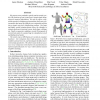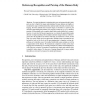CVPR
2011
IEEE
13 years 10 months ago
2011
IEEE
We propose a new method to quickly and accurately predict 3D positions of body joints from a single depth image, using no temporal information. We take an object recognition appro...
ICRA
2010
IEEE
14 years 12 days ago
2010
IEEE
Abstract-- We deal with the problem of detecting and identifying body parts in depth images at video frame rates. Our solution involves a novel interest point detector for mesh and...
ICPR
2010
IEEE
14 years 12 days ago
2010
IEEE
For the 3D modeling of walking humans the determination of body pose and extraction of body parts, from the sensed 3D range data, are challenging image processing problems. Real b...
MVA
2002
14 years 2 months ago
2002
In order to track and recognize the movements of multiple people using multiple cameras, each person needs to be segmented and identified in the image of each camera. We propose a...
SIAMIS
2008
14 years 2 months ago
2008
One of the central problems of medical imaging is the 3D visualization of body parts. The 3D volume can be viewed in slices, but the extraction of a part requires a segmentation p...
BMVC
1998
14 years 3 months ago
1998
In this paper we describe a system for automatic gait analysis. Different kinds of human gait are recognized using sequences of grey
ICCV
1995
IEEE
14 years 6 months ago
1995
IEEE
We present a novel motion-based approach for the part determination and shape estimation of a human’s body parts. The novelty of the technique is that neither a prior model of t...
CVPR
2006
IEEE
14 years 8 months ago
2006
IEEE
Part-based tree-structured models have been widely used for 2D articulated human pose-estimation. These approaches admit efficient inference algorithms while capturing the import...
CVPR
2006
IEEE
14 years 8 months ago
2006
IEEE
Tracking of humans in videos is important for many applications. A major source of difficulty in performing this task is due to inter-human or scene occlusion. We present an appr...
EMMCVPR
2007
Springer
14 years 8 months ago
2007
Springer
Recognizing humans, estimating their pose and segmenting their body parts are key to high-level image understanding. Because humans are highly articulated, the range of deformation...


